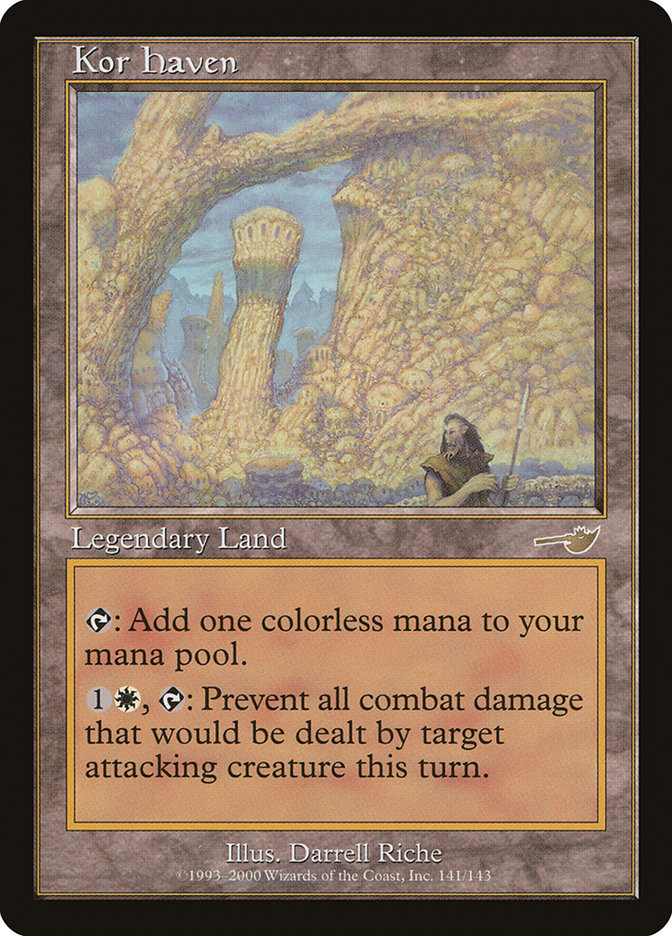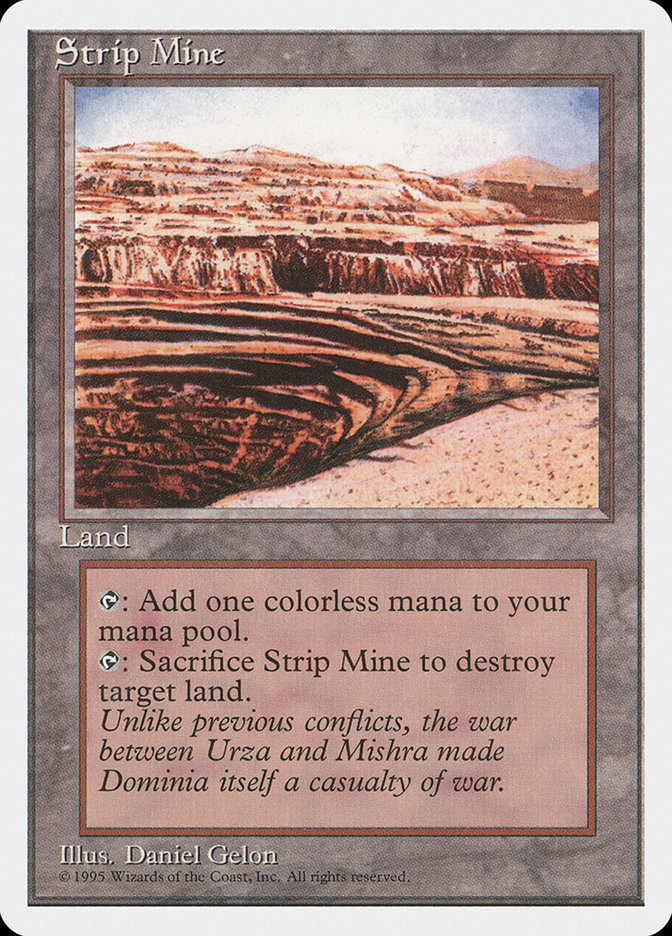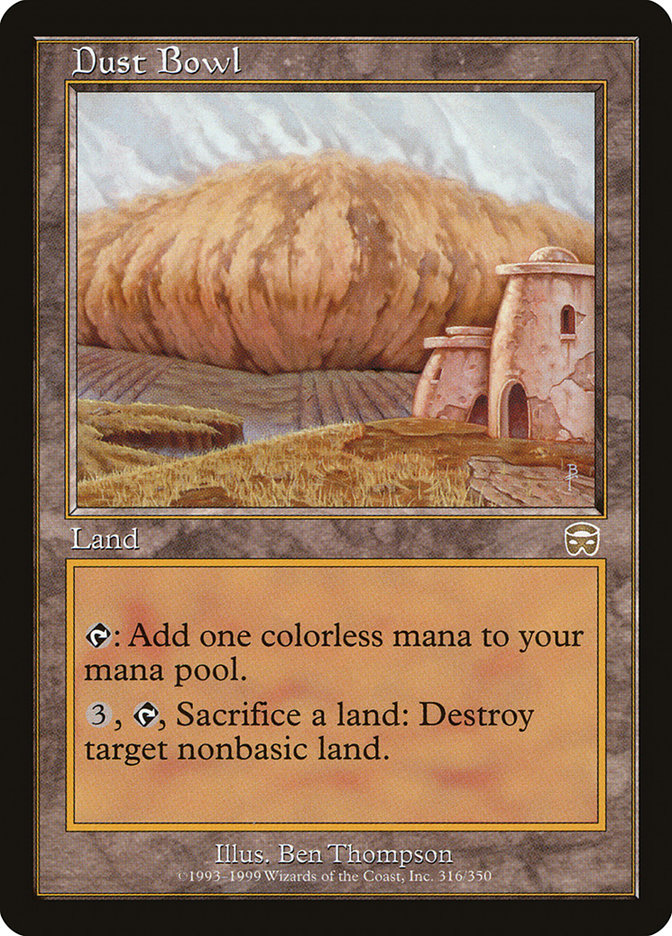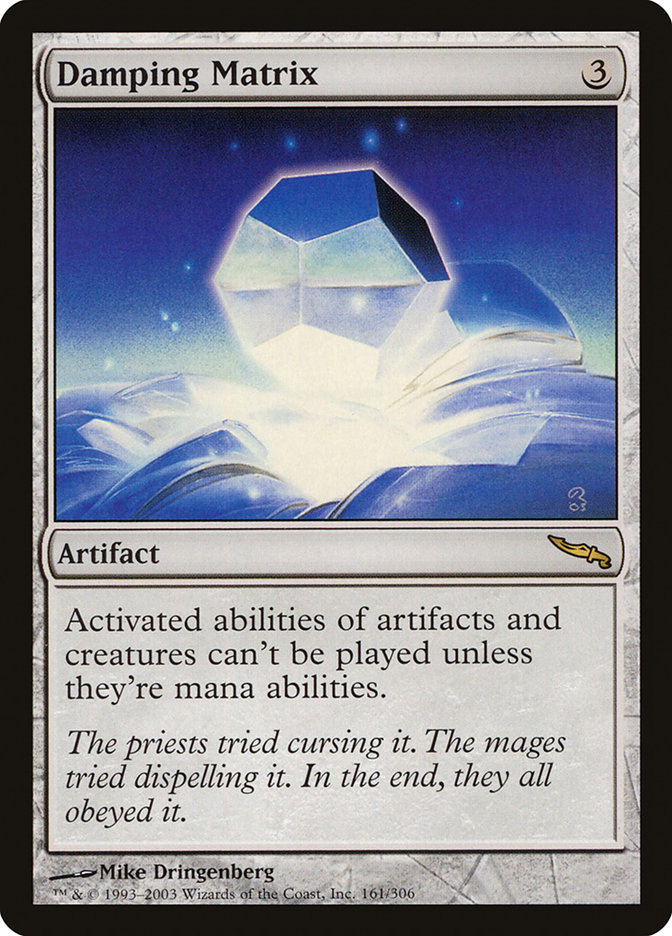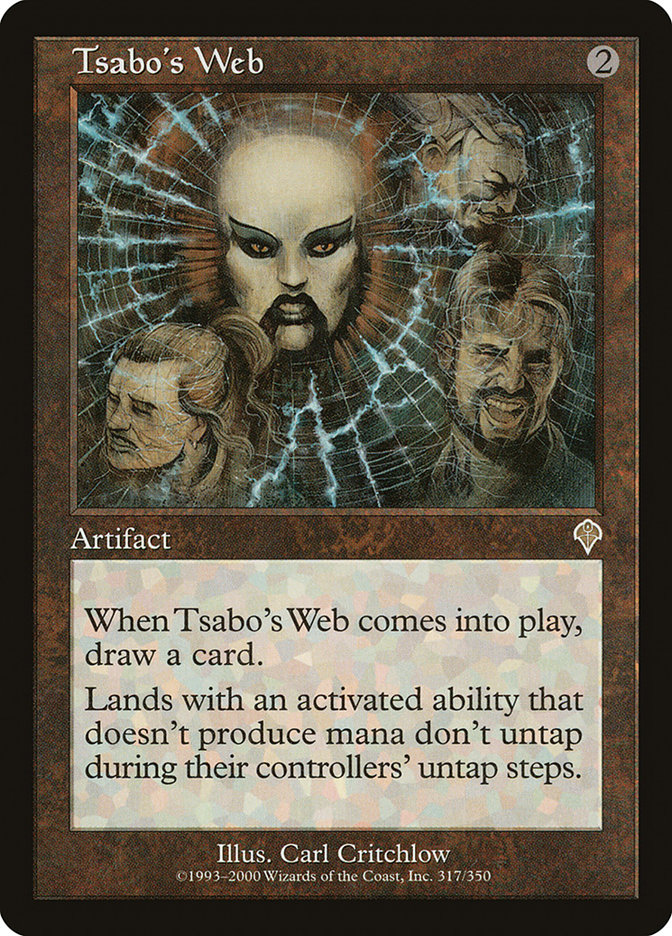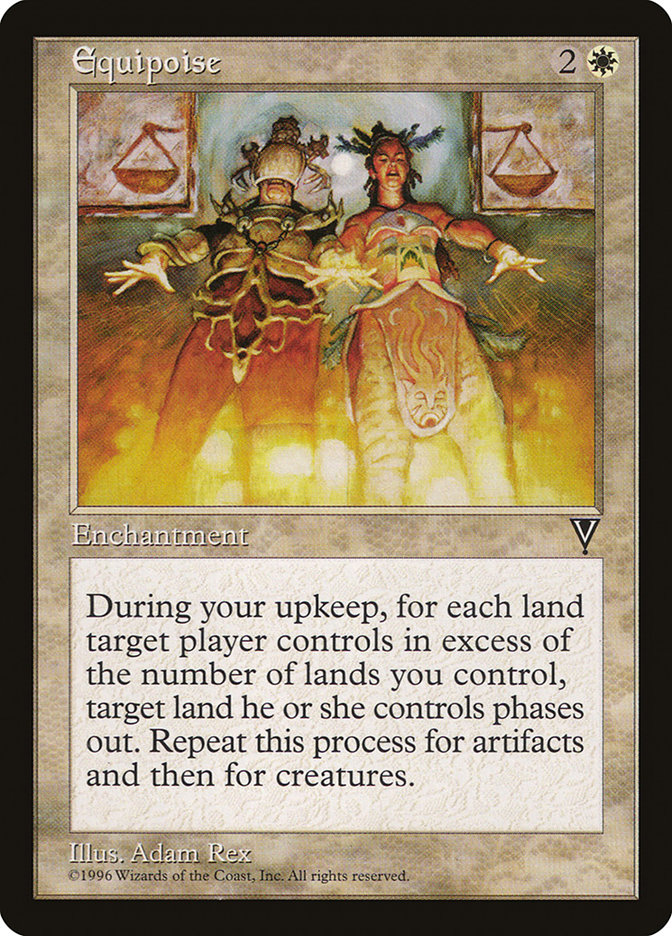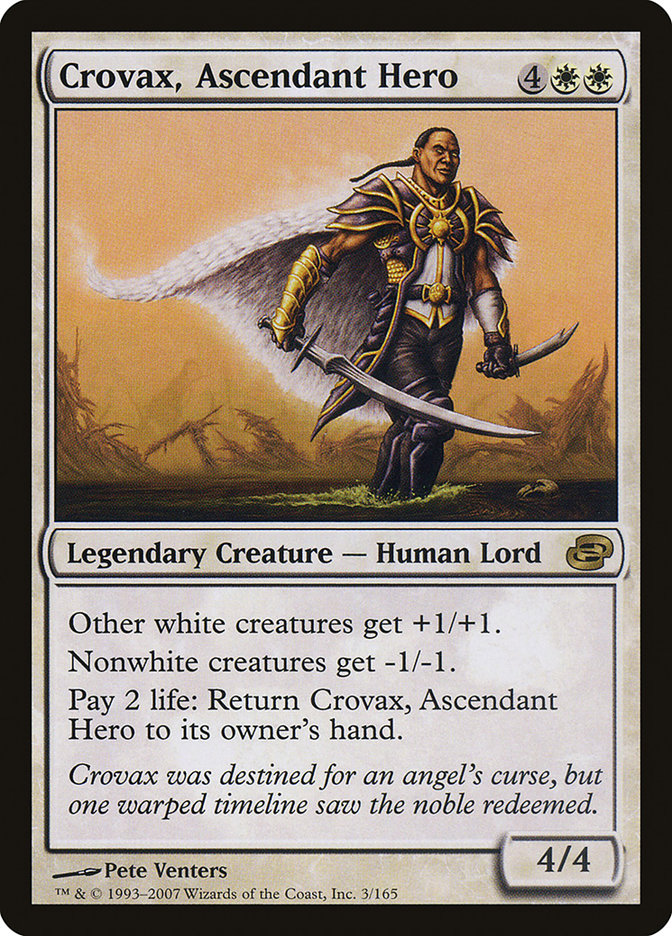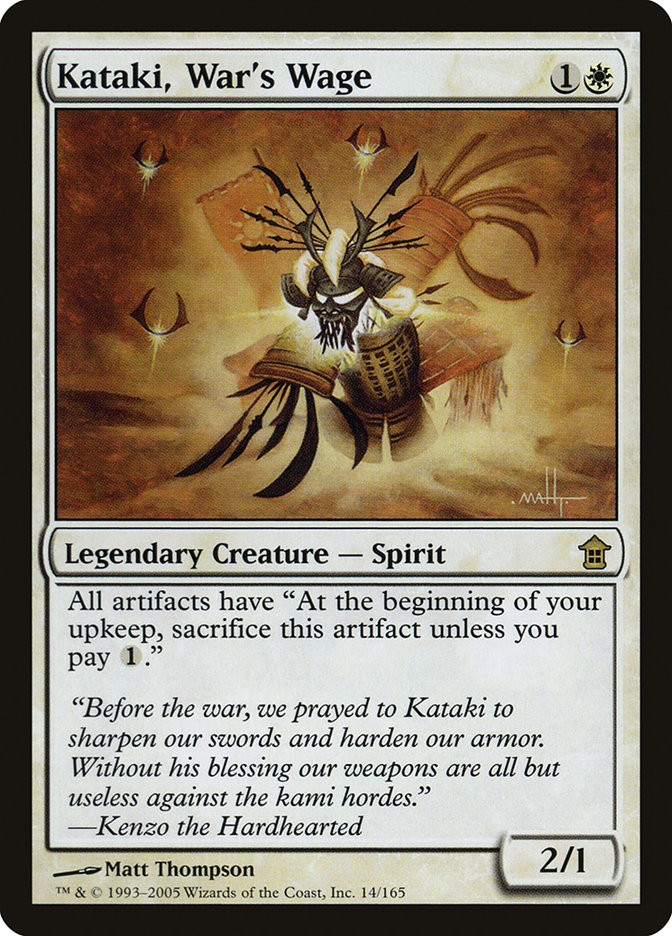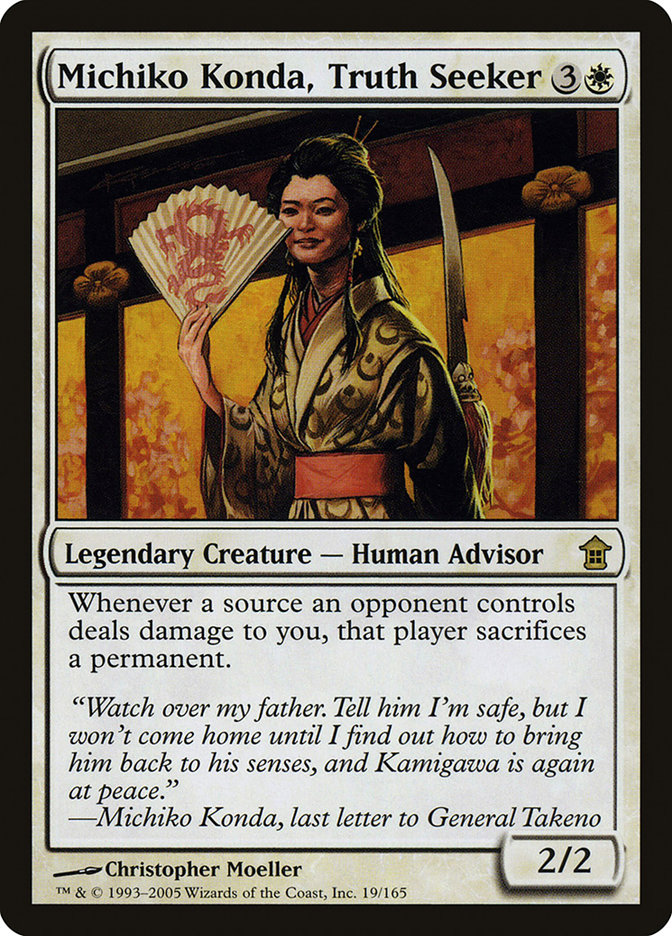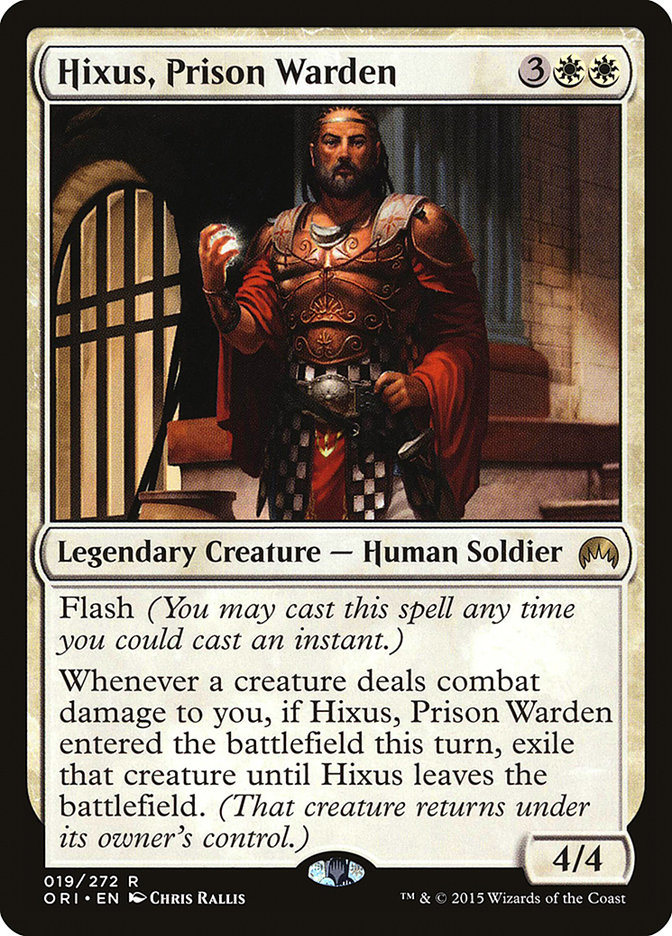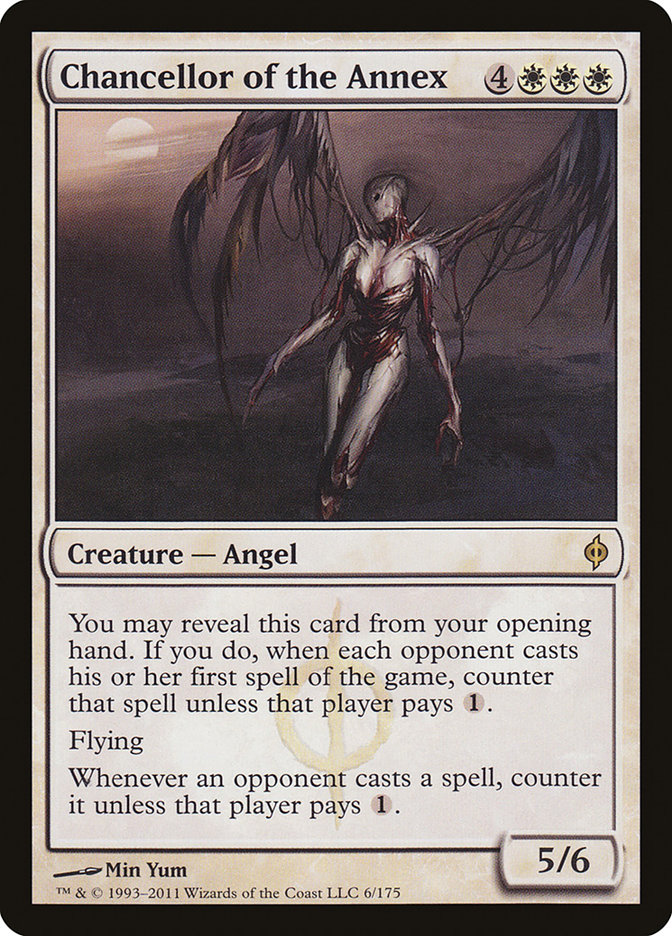Dear Azami,
I love the Commander community in my area, and those I’ve read online seem to be on a similar plane of understanding. Commander is about community. We are here to talk, chat, and socialize, all the while playing our favorite card game in the most amazing format. There are some Spikes out there running a busted Hermit Druid combo or something, but they can be ignored. Everybody else is solid gold.
That’s a part of the reason why I usually try extra hard to not be the Rules Police in Commander games. I am speaking both meta-wise (“That’s not how those triggers would stack!”) and in-game (Spirit of the Labyrinth, Ethersworn Canonist, etc.) However, after years of playing friendly games, I think I am ready to shake things up a bit. I think I am ready to become the curmudgeonly Middle School History Teacher walking around the classroom waiting for a student to try to pass a note or cheat on a test. And the card I want to helm this experiment is our new Thalia.
Commander: Thalia, Heretic Cathar
Creatures:
Spells:
Lands:
25 Plains
First, while this deck says “No” a lot, I am not sure of how well this thing will win. My main plan for winning is to have enough creatures and a team buffer like Jazal or Soul of Theros out and attack with a beefy swarm of creatures. Will that be good enough?
Also, was I too beholden to the theme of Fun Police? I want this to be a stick-in-the-mud type of deck, so I am fine with the theme. However, was I so obedient to the theme that I made missteps in creating a functioning deck? My card advantage is minimal.
My budget for this deck is about $80. I would like to sleeve this up and give it a shot with some local players (after warning them of the deck’s strict nature, of course). I feel like there are a couple of seasoned players who wouldn’t mind the challenge.
Thanks for any and all help you provide!
Beth
Re-writing the rules is definitely one of white’s stronger themes, and Thalia, Heretic Cathar does plenty of that. While her ability is probably stronger in 60-card formats – especially ones with fetchland manabases, where the nonbasic land side of the card will often slow players down for two turns rather than just one – having three times as many opponents to harass should make her an interesting choice at the helm of your deck. We can go really harsh here if we want to by reaching for cards like Winter Orb; Hokori, Dust Drinker; and Static Orb that would really punish opponents with Thalia’s Kismet effect, but that’s a little more antisocial than you’re looking for here, so we’ll mostly examine what’s working and fine-tune it rather than push off drastically in these other directions.
While either version of Thalia might encourage us to play a sort of “Death and Taxes”-style deck in Commander, complete with those mana-punishing cards and probably things like Armageddon, we’re going to rely on these rules-shifting cards to forceour opponents’ plans off of their pre-designed path rather than completely prevent them from operating on any axis. Cheap aggro Commanders plus Armageddon effects are totally a route you can take, and they’ll probably do well in most playgroups, but the interest here is in watching how your deck forces opponents to contort themselves outside of their comfort range and beat them while they are exposed; any negative feelings should be balanced by the fact that the game is interesting and strategic, forcing your opponents to try to find a way out of the puzzle.
Thalia is great at buying us time, but we don’t want to give our opponents too much of it. One of the downsides to a deck like this is that a rules-setting card that doesn’t actually interact with any given opponent on an axis their deck operates on is a waste of both mana and cardboard, so we can use a few more cards like that Mirror Entity and Soul of Theros to close the game out quickly.
A nine-drop like Nullstone Gargoyle is far too optimistic; this deck operates without any card advantage at all, so a seven-drop is probably the top end of what you can afford and it is quite a bit more expensive here than elsewhere in the format because you also are light on mana acceleration. I don’t think it’s wrong to skip the card advantage because every permanent you play that forbids an action that is relevant to your opponent will effectively be worth several cards by itself, so rather than restructure the deck to make room for it, I’m just going to readjust the deck’s expectations of what is and is not castable to account for its absence.
First things first, I’ve noticed this deck has only 97 cards… and only 34 lands when 37 is more-or-less the standard amount needed to draw a reasonable mix of lands and spells in the early stages of the game. I’ve long since misplaced the math I did to support that assertion, but 37 lands should give you a very solid chance of playing your fourth land on turn 4 and should make it quite rare indeed that you don’t have enough mana to cast Thalia on turn 3 as intended. So those two empty slots are going to become lands, and we’ll find room for one more cut somewhere along the way so we can add a third land and get to 37.
While this is definitely a Plains Matter kind of deck, thanks to the recursive strength of Emeria, the Sky Ruin, 25 is more than enough to get Emeria operating as a safety net in the later stages of the game to grind out of games you’d otherwise lose. All three additions are colorless, with Kor Haven operating as an effective second copy of your Mystifying Maze and the other two serving to harass our opponents’ manabases further.
Strip Mine is obviously the best version of this effect you can add and is still incredibly affordable despite this fact even after all of these years, while Dust Bowl is my go-to choice for the second such effect to add to a deck, allowing you to contain multiple opponents that might otherwise get out of control with Urborg plus Cabal Coffers or some other nonbasic land combination that absolutely must be broken up. Neither is intended to be used just because you’ve drawn them; they are here to add more tools to your tactical toolbox rather than try to play the cheap mage’s Time Walk like Strip Mine so often does in Cube.
Looking over your manabase, I see you have a Secluded Steppe but not a Drifting Meadow, so we are going to cut a Plains in order to add the second cycling land. I don’t want to add card advantage engines to this deck at the expense of everything else it is otherwise trying to accomplish, but when small opportunities to moderate our draw become available to us, we should happily play them. I’m glad to see you remembered New Benalia as well, because there is very little reason for anyone to remember it otherwise, but that small effect is likewise very valuable to this deck and deserves inclusion. The difference between 24 and 25 Plains for Emeria is minimal, so this is an easy substitution.
I’ve added three lands, and now I’m going to cut three mana artifacts. Pearl Medallion takes a lot of work before it’s better than Mind Stone, and most decks that have a Medallion in them probably shouldn’t. You really have to save multiple mana a turn before the cost savings is worth having such an inconsistent mana source, and this deck especially is just trying to play the best threat it can afford with the mana available to it each turn rather than have multi-spell turns.
Commander’s Sphere is okay but we’re not really ramping to anything, and at three mana to tap for one mana, it’s clearly the worst of the mana rocks available to us. And as prone as I am to put Expedition Map in every Commander deck, I’m not sure it’s actually that important to us – yes, we’d like to draw Emeria in games that go long, but there’s not much in the way of a boost otherwise for this deck and I’d rather focus on using our mana each turn on developing the battlefield rather than play a limited tutor effect.
One slot is going to be cut entirely to make room for that third land we added, and the two additions I want to make in this section both function as rules-setting cards that are sure to annoy your opponent.
In that good way, hopefully, where their plans fall to pieces and then you beat them… not in the “I didn’t get to play Magic” way that griefers shoot for. If your opponent wants to get to use their fancy toys, they can just play a bit more artifact destruction.
Conveniently, almost all of this deck’s artifacts are mana rocks that still work with Damping Matrix on the battlefield… and this deck is generally pretty light on the activated abilities from its creatures, so this is bound to muck up your opponents’ plans far more than it does your own. We rely on a lot of key cards to answer common problems in this format, and it’s not unusual at all to find Oblivion Stone, Nevinyrral’s Disk, and Perilous Vault hanging out in the same control deck these days.
Commanders like Roon of the Hidden Realm and Jhoira of the Ghitu just fall apart with a Damping Matrix on the battlefield, and there are plenty of decks built solidly around their commander’s characteristics that just get neutralized with this on the battlefield. It helps keep your permanents on the battlefield and makes opponents’ decks not work as intended; it’s just the kind of puzzle piece a deck like is looking for, so long as it’s not innately vulnerable to it.
This second addition is mean. It’s one thing when Thalia’s ability is a speed bump and quite another when instead she says your opponents do not get to play Magic, which is why we’re shying away from the miserable play experiences that Winter Orb et al. would bring us. Back to Basics would ultimately be the worst of all possible worlds, so we’re very thankful that it’s outside of our color identity where it cannot tempt us – but Tsabo’s Web is available to any mage that wants it, and it even draws you a card to replace it too.
If this consistently hosed every land our opponent played, it would be right off the table. We want to play Magic, not inflict misery, and having a Thalia deck that your opponent will only play against once is not the experience you’re looking for.
The large bulk of nonbasic lands untap just fine with a Tsabo’s Web on the battlefield, so it’s just hosing the format’s powerful utility lands… and the fetchlands that sometimes make the world go ’round, which doesn’t seem like much dirtier pool than the Aven Mindcensor and Leonin Arbiter you were already playing. It’s probably the roughest addition we’re making to the deck, since it can potentially wreck an opponent who just drew the wrong half of their manabase and couldn’t even use the land once because of Thalia, but it’s not like the format lacks solutions to two-mana artifacts.
Moving on to the spells, I have five cuts to make but six additions I want, meaning we’ll have to steal a slot from the creature section at the end. Return to Dust is a good card, but that’s all it is; it’s not really present for any strategic purpose and is instead a quality two-for-one. Tariff is mediocre removal at best, and while Fell the Mighty is interesting, I’m looking for something a bit more consistent as a Wrath effect here. Blind Obedience’s usefulness is mostly covered by Thalia already, and I think we can do better than True Conviction as far as creature pump effects are concerned, since there are more pump-plus-creature effects available if we want them.
If Tsabo’s Web was mean with Thalia, Crackdown must be absolutely vicious.
Rather than point Fell the Mighty at an opponent’s creature of the appropriate size, how about we just stop a whole bunch of them from ever being relevant in the first place? Messing with lands untapping is dirty pool, but turning off opposing creatures is perfectly acceptable. Sure, it doesn’t affect an opponent’s white creatures or their smaller ones, but most of the creatures we’ll actually care about will be halted in their tracks by this innocent-enough Mercadian Masques enchantment. I’ve never seen a mediocre Crackdown, just great ones and terrible ones, and with Thalia’s ability forcing opposing creatures to enter the battlefield tapped, I’m confident that we’ll be leaning towards the awesome here most of the time.
To make up for the fact that we’ve cut Expedition Map from your manabase, I’m adding Tithe as its replacement. Instead of finding your utility lands, Tithe offers a much-needed two-for-one at such a low cost that it’s basically invisible. Little effects add up to build a stronger deck, and while Land Tax could be stronger here, it would put us over your budget. The likelihood you’ll actually need multiple uses out of it is pretty small now that your curve stops at seven instead of nine, but if you want to go over budget, a copy of Land Tax would also go well here to make sure you can hit your high drops on a reasonable timetable.
Martyr’s Bond is great, especially at keeping opposing creatures from overwhelming you, so anything that operates at or near the same axis is going to be welcome in this deck. This deck wants to keep its permanents on the battlefield to the point where Rootborn Defenses is played just as Wrath defense, but there are more ways to put pressure on an opponent’s decisions than just saying no. Karmic Justice applies pressure in the worst way possible: mess with my stuff and I’ll mess with yours right back, possibly worse than you did in the first place. It’s not a rules-setting card, but it shifts an opponent’s behavior just as well as one might, since it punishes the action instead of forbids it – and harshly, at that.
One problem this deck faces is that it might just be underpowered despite all of its best efforts. The good news is, white has a couple of “I Win” cards that are just ludicrously powerful in this format at practically no mana cost at all. I wanted to include both of them, but I ran into budget problems; it appears that Serra Ascendant has jumped pretty crazily in price while I was away, so like Land Tax, this would be an “Extended Budget” addition if you want to build past where I’ve taken this deck in the future. At a more reasonable budget point, we get to add Luminarch Ascension, which needs no ink to be spilled in its praises – play it early enough in the game and it’ll do the heavy lifting by itself, and later on it’ll still be a pretty powerful draw, since several of your cards directly prevent an opponent from attacking you or punishes them for doing so.
Our last two additions here dig deep into the archives of cards basically no one plays, but I don’t let other peoples’ opinions about the quality of my cardboard stop me when I’ve found just the right niche card to fill a role. I’d cut Return to Dust because it was just too good-stuff for the deck… a good chunk of the artifact problems are covered by adding that Damping Matrix or by the Stony Silence you’re already playing, while artifact creatures are not actually going to be that special, so the higher-value targets we’re thinking of targeting with it are very likely enchantments.
I’d originally considered Serenity, but we don’t want to wipe out our own permanents; we rely on keeping our stuff around in order to mess with opponents. Then I remembered that white’s occasional takes on Tranquility has included some downright peculiar cards and found Cleansing Meditation might just be perfect for this role. I was really hoping for something like Tranquil Grove for the deck when I searched up Serenity in the first place, and a one-sided Tranquility (even if it involves a few hoops being jumped through in order to reach threshold) is surprisingly valuable to what Thalia is trying to build here.
And for our last slot, an old favorite I keep trying to find new homes for…
Phasing is weird and hard to explain at the best of times, so let’s dig up the Oracle text on the card:
At the beginning of your upkeep, for each land target player controls in excess of the number you control, choose a land he or she controls, then the chosen permanents phase out. Repeat this process for artifacts and creatures. (While they’re phased out, they’re treated as though they don’t exist. They phase in before that player untaps during his or her next untap step.)
Phasing used to be “temporary exile,” but that is a concept that has rankled Mark Rosewater something mightily over the years, so now we just pretend that at certain times permanents just don’t exist and skip things bouncing in and out of exile entirely. Equipoise is like a permanent Balance every turn so long as you don’t mind that the effect is temporary… but even a temporary effect can still be quite strong. The important thing to know is that phasing out tokens is just as good as killing them, so Equipoise will be playing token-killing duties turn after turn. Phasing out lands can let you evade utility lands like Maze of Ith or get spells in under countermagic by picking the untapped blue sources, and Equipoise can likewise make it very difficult for an opponent to defend themselves – phase out the untapped creatures and attack around them.
It’s a complicated card and other than the token trick it’ll do almost nothing, but the nothing that it does will be very interesting and force your opponent to reconsider the actions they’re taking in case it ends badly for them. Getting away with Equipoise shenanigans has been basically my favorite thing in Magic for two decades now, and it will provide the most interesting “rule” Thalia can possibly set – you can’t have more things than I have without them getting messed with!
Moving on to the creatures, we have one slot we need to shave and seven total swaps I’d like to make, so we need to identify the eight creatures that are carrying the least weight and cut them.
Grand Abolisher and Loxodon Gatekeeper are backup versions of Thalia’s ability, and they don’t really warrant inclusion when we can rely on the fact that we effectively start the game with Thalia in hand. Grand Abolisher reduces opponent interaction on your turn but is otherwise just Grizzly Bears, which is also enough of a reason to cut Anafenza, Kin-Tree Spirit; we need our creatures to carry their own weight or to have a significant impact on the game in some other way, so out they go. Spelltithe Enforcer doesn’t do quite enough, especially since it offers another avenue to get around its effect besides spending the mana, while Nullstone Gargoyle costs too much to really consider.
Last to go will be the two versions of Odric – whether we’re talking about the Master Tactician or the Lunarch Marshal, the kinds of corner cases it takes to make Odric worthwhile just don’t happen often enough to keep them in. Sharing abilities is a very weak form of power boosting and would be better off as a straight power boost most of the time, and the battalion-like ability to dictate an opponent’s defenses would be more relevant if your creatures were consistently larger than everyone else’s. As-is, the best option is probably just to say “no blocks” and get in for the damage, and we can do better than that.
Both Crovax, Ascendant Hero and Elesh Norn, Grand Cenobite sit at the top of your curve, and they both provide vital assistance not just as power boosters but also as toughness reducers. Giving opposing creatures -1/-1 or -2/-2 is much better than merely doubling the bonus for your own creatures. Elesh Norn basically heaps a four-power advantage onto your creatures when battling opposing creatures, but it’s even better than that because the weaker members of their team will cease to exist before blockers are even declared. One of this deck’s key weaknesses is token strategies, so both of these will help considerably (as will that oddball Equipoise) in addition to helping you deal more damage to finish off your opponents.
I know I just talked about wanting to cut the two-drops back, but 8.5 Tails is much better than “just” a two-drop; we’re effectively talking about a Mother of Runes that scales in effectiveness for however much mana you have available. Keeping your cards on the table is an important priority for this deck, so even though I’ve gone and added a Damping Matrix that will be an obvious nonbo with this card, it’s still well worth including.
That Damping Matrix doesn’t turn off artifact mana, but Kataki very nearly does, adding a one-mana tax to each artifact you want to keep on the battlefield very quickly renders artifact ramp irrelevant, and considering how ubiquitous mana rocks are in this format, I think Kataki will keep your opponents from getting too far ahead of you. The small body is not ideal, but the ability is more than powerful enough in the context of this format to make up for that fact.
This deck has a good bit of side focus on pushing combat away from you. Propaganda effects make it difficult to attack you effectively and cards like Comeuppance can be incredibly devastating once they actually do. Michiko Konda, Truth Seeker and Hixus, Prison Warden both play in that same space. I thought the deck could warrant a bit more defense, and I really like how the deck will train opponents over time that attacking into open mana is a very, very risky prospect.
Chancellor of the Annex replaces Spelltithe Enforcer because the ability is non-optional and the body is better – a decent-sized flier is much more relevant to your late-game than a 3/3 Elephant. Drawing it in your opening hand is not particularly likely and we’re definitely not weighing the value of the card on those merits, but on the occasions when you actually do so you’ll be quite pleased to tell your opponents to slow down by a turn as that will make it even easier for Thalia to push them off balance.
Putting it all together, we get the following:
Creatures (34)
- 1 Eight-and-a-Half-Tails
- 1 Blinding Angel
- 1 Windborn Muse
- 1 Glowrider
- 1 Kataki, War's Wage
- 1 Michiko Konda, Truth Seeker
- 1 Crovax, Ascendant Hero
- 1 Aven Mindcensor
- 1 Mirror Entity
- 1 Ethersworn Canonist
- 1 Knight of the White Orchid
- 1 World Queller
- 1 Lodestone Golem
- 1 Deathless Angel
- 1 Linvala, Keeper of Silence
- 1 Leonin Arbiter
- 1 Sunblast Angel
- 1 Elesh Norn, Grand Cenobite
- 1 Chancellor of the Annex
- 1 Thalia, Guardian of Thraben
- 1 Angel of Jubilation
- 1 Frontline Medic
- 1 Spirit of the Labyrinth
- 1 Eidolon of Rhetoric
- 1 Soul of Theros
- 1 Hushwing Gryff
- 1 Avacyn, Guardian Angel
- 1 Jazal Goldmane
- 1 Angel of the Dire Hour
- 1 Containment Priest
- 1 Hixus, Prison Warden
- 1 Archangel of Tithes
- 1 Vryn Wingmare
- 1 Kalemne's Captain
Lands (37)
Spells (28)
- 1 Ghostly Prison
- 1 Sol Ring
- 1 Aura of Silence
- 1 Damping Matrix
- 1 Wayfarer's Bauble
- 1 Rule of Law
- 1 Oblation
- 1 Marble Diamond
- 1 Mind Stone
- 1 Tithe
- 1 Equipoise
- 1 Crackdown
- 1 Tsabo's Web
- 1 Karmic Justice
- 1 Cleansing Meditation
- 1 Dawn Charm
- 1 Mass Calcify
- 1 Lapse of Certainty
- 1 Luminarch Ascension
- 1 Martyr's Bond
- 1 Stony Silence
- 1 Rootborn Defenses
- 1 Rest in Peace
- 1 Council's Judgment
- 1 Comeuppance
- 1 Tragic Arrogance
- 1 Sword of the Animist
- 1 Hedron Archive

As always, for participating in this week’s edition of Dear Azami you will receive a $20 coupon to the StarCityGames.com Store; you’d mentioned an $80 budget, so I tried to stick with that pretty strictly, but if I’d had a bit more budget to play with, I think Land Tax would be useful to make up for the fact that the deck is otherwise lacking in card advantage and can use the help making its higher land drops.
I’m pretty confident you could cut any card in the deck, no matter how critical, and have the deck be better because you can cast Serra Ascendant on the first turn in a nonzero number of games. Within the budget you’d given me I felt it was more important to spend that kind of expense on Elesh Norn instead, since controlling opposing token hordes covers a major weakness you would regularly encounter, but with more to spend I’d consider it important to pick up white’s two most powerful one-mana cards.
Breaking the changes down individually by price, we get the following:
|
Card |
Cost |
|
$0.15 |
|
|
$0.35 |
|
|
$0.49 |
|
|
$0.59 |
|
|
$0.99 |
|
|
$0.99 |
|
|
$1.09 |
|
|
$1.49 |
|
|
$1.99 |
|
|
$2.49 |
|
|
$2.49 |
|
|
$3.59 |
|
|
$5.49 |
|
|
$5.95 |
|
|
$6.15 |
|
|
$6.65 |
|
|
$9.99 |
|
|
$12.99 |
|
|
$18.75 |
|
|
$82.67 |
This should smooth out your mana draws, add a few more powerful disruptive elements while also improving your defenses and your ability to keep key cards on the table, and add a few more power boosts to help close the game out when it’s going long and your opponents are starting to work around the barriers you’re throwing in the way. We’ve added a few mean tricks that capitalize on Thalia’s excellent ability, with Crackdown preventing their large creatures from ever being relevant and Tsabo’s Web harassing utility lands and fetchland-heavy manabases alike. Their mana will also be taxed by Kataki, preventing mana rocks from being real acceleration effects, and by the restrictions Leonin Arbiter and Aven Mindcensor place on searching the library. Thalia, Guardian of Thraben; Vryn Wingmare; and even Chancellor of the Annex will slow down your opponents from deploying too fast.
The hope is that the deck is hard to play against but not actually frustrating, providing an intellectual challenge as your opponents try to puzzle out how they can advance their battlefield position despite the restrictions you’re placing upon them, rather than just saying “no” to any and all forward progress. But that’s a fine line to walk with this deck, so it may be a deck you use only occasionally with your playgroup to challenge them rather than as your primary weapon. You wanted to test out being the curmudgeon at the table, and this deck certainly does that, but this is a role best played only intermittently before your welcome within the community starts to become tenuous.
I’m confident you’ll be able to walk that line, and this is certainly a deck that gives you the right tools to do so while trying not to go full-on griefer. I wouldn’t want to face it with any regularity because I like solving my own puzzles to find victory, not someone else’s, as I can plan for my own puzzles when building my deck and having all these extra curveballs thrown at me requires thinking on-the-spot instead of my usual trick of “proper prior planning prevents poor performance.” It certainly showcases Thalia, Heretic Cathar’s strength as a Commander, and I’d doubted that before picking your deck this week; if you can convert me to this new way of thinking, surely it will be an enlightening experience for your opponents as well.
Want to submit a deck for consideration to Dear Azami? We’re always accepting deck submissions to consider for use in a future article, like Dina’s Ulrich of the Krallenhorde deck or Jamal’s Ishkanah, Grafwidow deck. Only one deck submission will be chosen per article, but being selected for the next edition of Dear Azami includes not just deck advice but also a $20 coupon to StarCityGames.com!
Email us a deck submission using this link here!
Like what you’ve seen? Feel free to explore more of Dear Azami here, in the Article Archives! And feel free to follow Sean on Facebook… sometimes there are extra surprises and bonus content to be found over on his Facebook Fan Page as well as previews of future columns!


